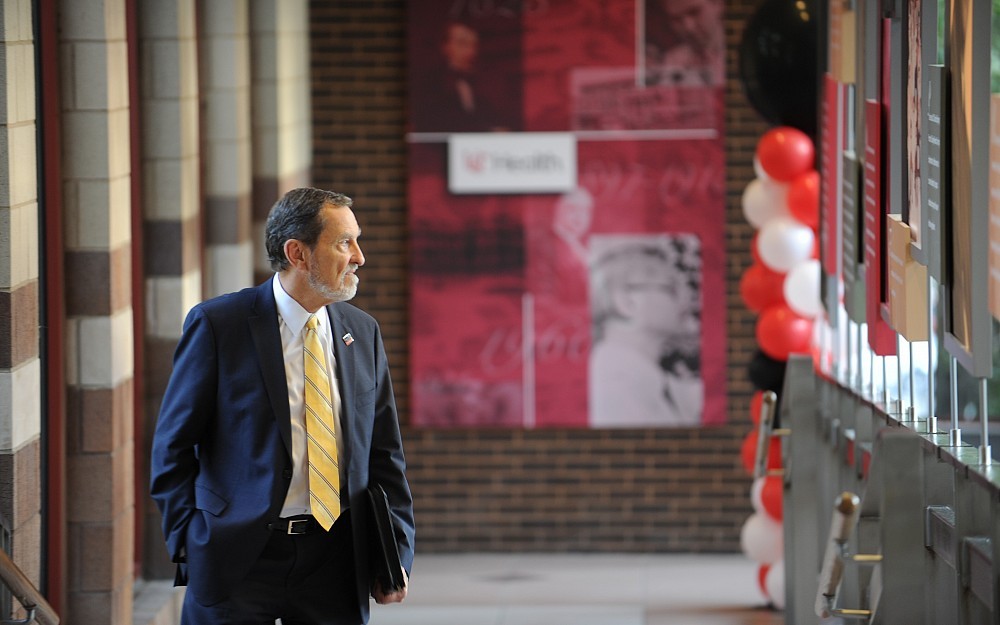
History and Innovation on Display at University Hospital
UC Health University Hospital traces its history back to 1823 with the opening of the Commercial Hospital and Lunatic Asylumthe first teaching hospital of the Medical College of Ohio.
The Medical College of Ohio was established in 1819 by Dr. Daniel Drake and was a precursor to the University of Cincinnati College of Medicine.
This long history and connection to an academic medical center has given rise to many "firsts in patient care, research and education, including:
The development of new training programs in nursing and emergency medicine.
The use of lasers for patient care in dermatology and neurosurgery.
Funded research partnerships with the U.S. military aimed at improving care for soldiers in combat.
Highlights of University Hospitals history and its leadership in innovation can be seen in the "University Hospital Innovation and Discovery exhibita permanent lobby showcase unveiled Thursday, Sept. 13.
W. Brian Gibler, MD, president and CEO of University Hospital, said the exhibit was designed to celebrate a rich past and continue to encourage the culture of excellence that exists within the hospital.
"Everyone is important. Everyone who does work here is doing mission-critical work, said Gibler.
"When I visit other hospitals, I can see that they celebrate their past, said Gibler. "But were actually older than most of those institutions. We must celebrate that history. When we participate in care here, we are participating in care thats now 190 years old.
The exhibit boasts:
Fourteen vignettes (20 images total) with descriptive text lining the corridor from Goodman Garage to the University Hospital lobby. This museum-quality "walk highlights history and innovation at University Hospital.
Two display cases near the lobby desk showcasing a rotating display of historical medical artifacts on loan from the University of Cincinnatis Henry R. Winkler Center for the History of the Health Professions. Select items currently on display are a tissue slicer patented in 1908, a medical illustration of the lung and a metal "suit used for maggot therapy for burn victims.
Eight framed images surrounding a UC Health logo and highlighting present-day University Hospital and the hospital through time. These include photos of the surgical amphitheater (1950 and 2012), Cincinnati General Hospital circa 1920, Cincinnati Hospital in 1859 (positioned along the Miami and Erie Canal, now Central Parkway), the UC College of Medicine in 1918, a present-day photo of the Barrett Center and a 2009 aerial view of the UC Medical Campus.
"Then and now aerial photos showing the medical campus as it was in 1960 and as it is now in 2012.
Tile mosaic displaying an image of University Hospital. At approximately 9 feet by 5 feet, the mosaic comprises approximately 5,000 tileswith each individual tile featuring a face of a University Hospital employee.
The present-day photographs featured in the exhibit were taken by Dan Davenport, senior medical photographer with UCs Academic Health Center Public Relations and Communications Office. Amy Hirsch, executive assistant to Gibler, led the committee charged with creating the exhibit. She was supported by Becky Sittason and Liz Keating, both from the UC Health Foundation.

A mosaic (nearly 9 feet wide and 5 feet tall) portrays the image of University Hospital with "tiles" made up of faces of University Hospital employees. W. Brian Gibler, MD, president and CEO of University Hospital (right), presided over the unveiling of the mosaic and a full lobby exhibit during a Sept. 13 event.

W. Brian Gibler, MD, president and CEO of University Hospital, unveiled a new lobby exhibit and Air Care & Mobile Care helicopter at a Sept. 13 event celebrating history, innovation and the future.
Related Stories
UC researcher launches app to connect patients to lifesaving...
May 7, 2025
A cardiologist and researcher at UC’s College of Medicine joined the Venture Lab at the 1819 Innovation Hub to launch High Enroll, an app that links clinical trials with willing participants.
Growing heart failure epidemic calls for prioritizing primary...
May 5, 2025
A rapidly growing heart failure epidemic calls for prioritizing primary prevention, according to a new scientific statement from the American Heart Association published in Circulation in April. The statement reviews the current evidence for predicting heart failure risk and offers risk-based strategies for heart failure prevention.
Machine learning brings new insights to cell’s role in...
April 30, 2025
Researchers led by the University of Cincinnati’s Anna Kruyer and the University of Houston’s Demetrio Labate have published research in the journal Science Advances applying object recognition technology to track changes in brain cell structure and provide new insights into how the brain responds to heroin use, withdrawal and relapse.
